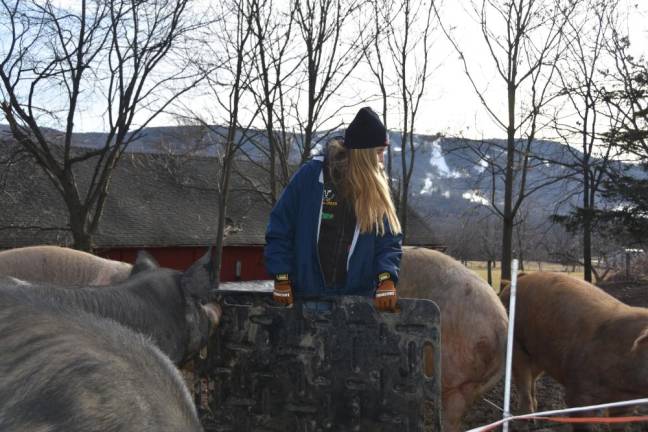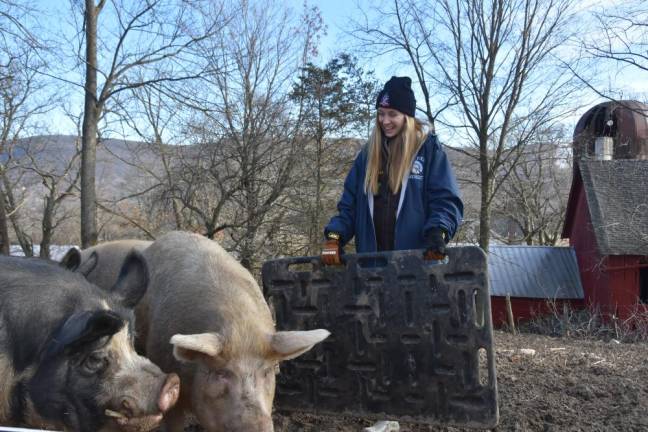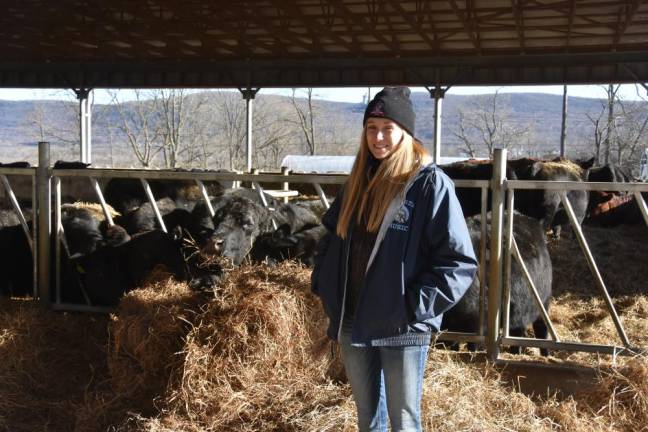Training for an 800-pound patient
From New Jersey to Ireland, a vet student’s international education



Like every aspiring vet, Jessica Ciona, 23, loves animals, but she’s particularly interested in helping to correct what she feels is a blind spot when it comes to how we treat livestock. From Sparta, NJ, Ciona is one of about 40 North American students in their first year of veterinary school at the University College Dublin.
She chose Ireland partly because tuition was cheaper; partly because “I figured when else am I going to have the chance to go study in a different country?”; and partly because they have the biggest animal hospital in the country, plus on-campus animals like cows and of course sheep.
Not so much pigs, though. So while she was home on break, she found a farm with beef cows and pigs where she could get some experience. Farmer Christina Arellano of Vernon Valley Farm in Sussex, NJ, took Ciona under her wing for the week. The two women, both slight of frame, worked together handling some of the most massive patrons Ciona is likely to serve in her career.
“Hanging out with these pigs, they act like pets,” said Ciona. “Obviously they’re not, but you want to give them the best quality of life, regardless. So I think that’s probably my number one going into” the veterinary field, she said. “Because we have such a big impact. Whatever we decide to do really affects them. As humans, we hold pretty much everything in our hands. We have the power to make all their decisions for them.”
Arellano and her partner Kirk Stephens don’t often call a vet themselves. Their animals live outside and are generally healthy, first of all, and second, it’s unlikely a vet can tell them anything they don’t already know about their animals. These days, as Vernon Valley Farm’s reputation spreads, they don’t accept just every intern who expresses an interest, either. But Arellano sensed a seriousness in Ciona, and had been thoughtful about exposing her to the kinds of experiences that would prove valuable down the road.
“Yeah, so I kind of look like I know what I’m doing when the time comes,” said Ciona. “I have to get in there and feel confident around an animal, kind of understand what’s normal and what’s not.”
So far, they had worked together to separate two steers from the herd of beef cattle, get them into the corral and load them into the trailer to send to slaughter – which, Ciona learned, is much more difficult than moving all the cows together, because of their herding behavior.
Ciona had plenty of experience with dairy cows, having tended them while she was an undergrad at the University of Vermont, which has a student-run milking herd. “But it’s definitely different with beef cattle. The dairy cattle I was with, we were with them every single day, so their flight zones” – the area around an animal where they’ll run away if approached – “they could be small, and they were easy because they knew us.”
Different as it was, herding the steers didn’t actually turn out to be that hard, said Ciona. That's because, if you’ve seen Arellano around her animals, you know she’s something of a whisperer. “She just jumped in the trailer and they pretty much just went right in the trailer. It was pretty easy,” Ciona said. “I guess the biggest part was the preparation of closing all the gates and making sure everything was ready for the moving of them.”
The pair took a field trip to Lowland Farm in Warwick, NY, where Arellano keeps a herd of free-range spotted pigs. Eleven of them clustered around Ciona, sniffing – but these pigs, intended for pork, only came up to her thighs, a manageable size.
“Significantly smaller,” laughed Ciona, perhaps a tad nervously, as she stepped over a strand of electric fencing to get some quality time with the breeding stock, back at Vernon Valley Farm. These pigs stand waist-high and weigh up to 800 pounds each.
“You don’t want the other pigs to get this big,” explained Arellano. “You don’t want fatty bacon.” But these sows were responsible for making piglets – which come in litters of between six and 13 – and were allowed to eat more. They put away food by the tractor-trailer load, when available, like a big load of pineapples that got rejected from the grocery store. Thor, the boar, has a set of tusks jutting out from his lower lip, one of which is broken, which only adds to the effect.
“You might feel more comfortable with the pig shield, probably,” Arellano had suggested, so Ciona was holding a lightweight black plastic barricade resembling a policeman’s riot shield between herself and the snuffling pigs. The shield is more of a psychological than a physical tool, cutting off the pigs’ line of sight to the area you don’t want them to go.
Ciona had been in here earlier, with Arellano, as they tried herding two of these pigs to their hut, just for practice. One had walked right into the hut, the other had given them the runaround.
“We just kind of tried to make ‘em go where we wanted ‘em to go, which is difficult because pigs don’t go where you want them to go,” explained Arellano. “They go where they want to go.”
That was clear as Ciona walked toward the pigs now holding the shield. A couple of the giants mosied around behind her, rubbing up against her back. Ciona whipped her head around to check what was going on back there, no longer smiling for the camera. This was definitely some hands-on experience.
“I feel comfortable, but only because these are my animals,” Arellano narrated, as we watched Ciona being surrounded by pigs. “I would definitely have a healthy fear of any large animal because they’re powerful. Our boar is super nice but...”
“I really knew almost zero about pigs coming in,” said Ciona, after she’d stepped out. “Temperament, honestly how big they can get, moving them. I didn’t know a pig shield was a thing. Their coat type – how they’re okay to be outside in such cold temperatures, just all the fat.”
Ciona’s next internship will be lambing at a family farm in Northern Ireland over spring break. “It’s kind of been nice to see how you run this farm, too, because every farm is so different, especially Ireland versus here, and Vermont,” Ciona told Arellano. “I feel like that’s good to know even though I probably won’t be farming; it’s just good to know that side, too, so I can be relatable.”